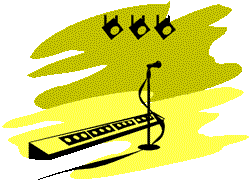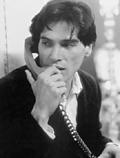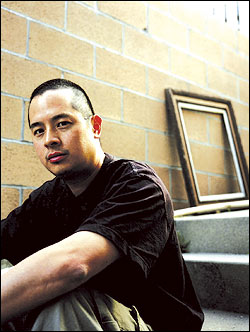The Dylan Industry never rests. It forges ahead, impervious to time, place, fashion, and fancy, growing larger by the year while the man at the center of its attentions—when not doing the steering himself—tends to remain cagey, canny, private, poker-faced. Paul Williams, the author of five Dylan books and counting, once noted that there’s always a Dylan retrospective going on somewhere. The Dylan Industry makes sure this stays so; it maintains a steady thrum and kicks into gear every three or four years, generally timed to a major Dylan event. The last couple times were albums: 1997’s Time Out of Mind (its momentum sustained by Live 1966, a legendary bootleg officially released for the first time the following year) and 2001’s “Love and Theft.” Although 2004 saw the issue of the over-praised The Bootleg Series Volume 6: Live 1964—Concert at Philharmonic Hall (Columbia/Legacy), now the spotlight’s on a book—and, the Experience Music Project hopes, on a related exhibit.
The most interesting thing about the Dylan Industry is that it’s self-generating, and nowhere more than in publishing, the Industry’s epicenter. The literary market is never short of new Dylan product, especially this year—I’ve seen no less than a dozen new or updated books in 2004, and I’ve probably missed a few. Needless to say, no normal person need bother with most of them. This isn’t always an insult: Oliver Trager’s Keys to the Rain: The Definitive Bob Dylan Encyclopedia (Billboard) may be classic forest-for-trees fanaticism, but it’s info-crammed enough for a professional to find handy as a reference. But try to find any use for A Simple Twist of Fate: Bob Dylan and the Making of Blood on the Tracks (Da Capo), in which British writer Andy Gill provides pompous commentary while co-author Kevin Odegard recalls, in monotonous detail, which instruments he and his fellow musicians used while playing on the half of the album that was recorded in Minneapolis.
This year has also seen microscopic studies by Michael Gray (the third edition of Song & Dance Man: The Art of Bob Dylan) and Christopher Ricks (Dylan’s Visions of Sin, the highest-profile of these books—aside from Dylan’s own—thanks to Ricks’ clout as a poetry-world heavy). There’s David Boucher’s comparative study of Dylan and Leonard Cohen; Jim Ellison’s useful, if frustrating, Younger Than That Now: The Collected Interviews With Bob Dylan (which misses two classics—Playboy, 1966, by Nat Hentoff, and Rolling Stone, 2001, by Mikal Gilmore); and Benjamin Hedin’s less useful Studio A: The Bob Dylan Reader. There’s even a Rough Guides volume by Nigel Williamson that sums it all up nicely, as is the series’ wont, though it’s pretty humdrum critically: When Williamson writes, “‘Love and Theft’ is not as important an album as Time Out of Mind,” it’s essentially code for “Time Out of Mind is a lot more boring than ‘Love and Theft.’” And then there’s Dylan’s Lyrics 1962–2001, which has been kicking around in various guises since 1973 and is exactly what it looks like.
So, shockingly, is Chronicles: Volume One (Simon & Schuster), the first of three projected memoirs by Dylan himself. If you’ve set foot in a bookstore or picked up a mass-market publication this fall, you have probably figured out that this tome—one of the shortest of the new books—is the Big Kahuna in all of Dylania right now. The undercurrent of every review I’ve seen of the thing has been sheer disbelief that it even exists. “A lot of the Dylanologists I talked to when I was putting this together were shocked it even came out,” says Jasen Emmons, the curator of EMP’s new exhibit, “Bob Dylan’s American Journey, 1956–1966,” which opens Saturday, Nov. 20. “It had been rumored for so long that everyone was convinced it would never happen.”
Or worse, that the result would be evasive in some manner: Maybe gnomic on the order of Tarantula, Dylan’s first book, written in 1965 and issued five years later (essentially a semipoetic absurdist riff, a long version of the liner notes from one of his ’60s albums), or maybe a glossy rundown of hard facts that would skip or deny the thornier aspects of his life. But it turns out that Dylan remembers more than you’ll ever forget, and he remembers in detail. It’s tempting to compare the reception of the book with that of Brian Wilson Presents Smile, the wholly rerecorded version of a scrapped, 37-year-old Beach Boys album that several influential critics are calling the album of the year. The difference is that even in unfinished, bootlegged form, Smile always depended to some degree on the listener’s willingness to be swept away by Wilson’s aural fantasias. Even at his most fanciful, Dylan has never offered much in the way of escape.
Which isn’t to say that Chronicles doesn’t traffic in nostalgia to some degree. It’s just that the nostalgia belongs entirely to Dylan and not his fans. The three periods he writes about—from high school to his signing with Columbia Records (which scene begins and ends the book), encompassing his apprenticeship in Minneapolis’ and New York’s folk scenes, and the making of two albums, 1970’s New Morning and 1989’s Oh Mercy—have little resonance for the public at large; after fallow periods, both albums were considered “comebacks” upon release, but today nobody but hard-core Dylanologists considers them major works.
Still, their placement here is instructive. These periods connect not as straight narration but instinctively, as crossroads in Dylan’s attempt to get and keep a grip on his art—the early years as hungry young visionary, New Morning as family man and reluctant celebrity, Oh Mercy as someone drifting away from himself and being restored thanks to an outside trigger. This falls right in line with Dylan’s instinctive approach to his art generally; often, his through-lines are implied more than stated outright. Take the narrative Blood on the Tracks‘ “Tangled Up in Blue,” which slips between first and second person but retains its coherence. That instinctiveness is in the writing itself, too—Dylan’s tone has a drifting romanticism about it even when he’s bearing down: “I did everything fast. Thought fast, ate fast, talked fast and walked fast. I even sang my songs fast. I needed to slow my mind down if I was going to be a composer with anything to say.”
For all its lack of linearity, Chronicles is amazingly lucid and specific. Dylan goes on at length about his heroes, and he’s extremely good at pinpointing their appeal. On Joan Baez: “Both Scot and Mex, she looked like a religious icon, like somebody you’d sacrifice yourself for and she sang in a voice straight to God . . . also was an exceptionally good instrumentalist.” (The ellipse is Dylan’s, by the way.) On Albert Grossman, his manager: “Usually when he talked, his voice was loud, like the booming of war drums.” On Bertolt Brecht and Kurt Weill’s “Pirate Jenny”: “Each phrase comes at you from a ten-foot drop, scuttles across the road and then another one comes like a punch on the chin. And then there’s always that ghost chorus about the black ship that steps in, fences it all off and locks it up tighter than a drum. It’s a nasty song, sung by an evil fiend, and when she’s done singing, there’s not a word to say. It leaves you breathless. In the small theater when the performance reached its climactic end the entire audience was stunned, sat back and clutched their collective solar plexus.”
Like his greatest albums, Chronicles has a voraciousness and force of personality that overwhelm petty objections. If Dylan’s recollections are breathless, they’re also hard-nosed, and that’s appropriate to the sense of discovery afoot as well as the extreme bitterness he details about dealing with the fame he’d gained in the late ’60s, a period when he was seen as a figurehead for a movement he wanted nothing to do with. (He rattles off the titles—”the Big Bubba of Rebellion, High Priest of Protest, the Czar of Dissent, the Duke of Disobedience, Leader of the Freeloaders, Kaiser of Apostasy, Archbishop of Anarchy, the Big Cheese”—with both perfect comic pacing and a real sense of anguish at the trap he’d gotten into.) It’s a long, frequently excitable exhalation, as if years of keeping this stuff mostly to himself had finally become too much, a mirror image of his early need to be heard.
That’s equally true of the lengthy description of approaches to performing that Dylan credits for reviving his interest in his own music in the late ’80s. After skipping out on a rehearsal with tour mates the Grateful Dead (“I wasn’t planning on going back. If you have to lie, you should do it quickly and as well as you can”), he stepped into a bar to watch a jazz combo and began paying attention to the singer, who “wasn’t very forceful, but he didn’t have to be; he was relaxed; but he sang with natural power.” Dylan went back to rehearsal and started over, in more ways than one, eventually adding a guitar technique learned from bluesman Lonnie Johnson that works entirely on mathematical principles: “I’m not a numerologist. I don’t know why the number 3 is more metaphysically powerful than the number 2, but it is.” It’s both nuts-and-boltsy and metaphysical—a good description of Chronicles as a whole.
Apparently, Dylan’s looking-back mood extends beyond his book pages. The EMP exhibit “Bob Dylan’s American Journey” was put together with his cooperation; he allowed some 10 hours of interview footage shot in 2002 for a Beatles Anthology–style project (due in 2005), helmed by Martin Scorsese, to be incorporated into the four short videos that will screen alongside the artifacts. In addition, the exhibit will include six scenes apiece from Don’t Look Back, D.A. Pennebaker’s documentary of Dylan’s 1965 tour of England, and the officially unreleased Eat the Document, which Pennebaker filmed a year later when Dylan was on the road with the Hawks (the backing band who’d later become the Band) in Europe.
On EMP’s top level, parallel to the permanent Jimi Hendrix display, the exhibit’s glass opening faces an open hallway with a giant Dylan head at the end, visible from across the hall. On the outer wall are printed lyrics from 15 Dylan songs from the period, from “Song to Woody” to “Sad-Eyed Lady of the Lowlands,” with plenty of Dylan-the-rebel-poet represented: “Masters of War,” “The Times They Are a-Changin’,” “A Hard Rain’s a-Gonna Fall,” “With God on Our Side,” “Ballad of a Thin Man.” EMP is importing 1,500 pounds of rust-colored rock from Hibbing, Minn., for the section on Dylan’s hometown. The exhibit’s Woody Guthrie nook features, among other artifacts, the teenaged Dylan’s copy of Guthrie’s auto- biography, Bound for Glory. And each of Dylan’s first seven albums gets its own listening station where you can hear album cuts, live versions, outtakes, bootlegs, and covers by other artists.
It is, in short, almost exactly opposite in tone from Chronicles: The book is an impressionistic guide to a forming sensibility; the exhibit is concerned with nailing down concrete dates. What guides both is Dylan’s sudden generosity with his own past—as if the artistic success of Time Out of Mind and “Love and Theft” has allowed him to talk about the old stuff in depth without feeling like he’s trading in on it at the expense of the new. And for a guy with a reputation as a grouch (see Don’t Look Back and roughly two-thirds of the aforementioned Collected Interviews), he’s been amazingly frisky of late. In the short film about his appearances at Newport that screens at the exhibit, the footage of a young Dylan performing “Bob Dylan’s Dream” in full-on deadpan-comic mode comes closest to the wryness of the recent footage.
In fact, there’s something familiar to me about that wryness, and not just because he’s an icon or is the subject of a museum retrospective or has written one of the music books of the year. It’s personal, and it’s regional. I spent my first 24 years in Minneapolis, and when Dylan talks, it’s instantly familiar: He sounds like other old guys I know from Minnesota, who left upstate for the city, who worked at losing their regionalisms only to have them reassert themselves with age and self-comfort.
There’s a clip in EMP’s short film about Dylan’s legacy, taken from Eat the Document, that stays with me. He’s onstage, seated at a piano, performing “Ballad of a Thin Man.” On Highway 61 Revisited, the song always sounded a little narrow, too proud of itself; here, it’s like death wearing a clown mask. He’s stoned, probably, but where it proves an irritant on Live 1964, here it hardly matters, because Dylan is all the way in the zone—kinking his delivery, slurring and elongating his vowels in a way that suggests Dylan imitator but communicates as the man himself at his most absolutely powerful, completely in command of his instrument, bending and shaping his art at will. There are a lot of differences between that clip and Chronicles: Volume One—age, intent, method. But in net effect, they’re not so far away from each other.
“Bob Dylan’s American Journey, 1956–1966” opens at Experience Music Project Sat., Nov. 20.








